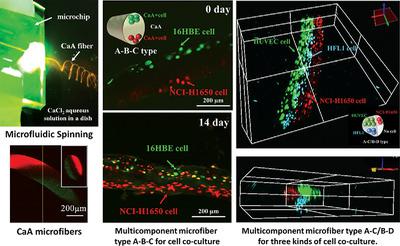当前位置:
X-MOL 学术
›
Macromol. Biosci.
›
论文详情
Our official English website, www.x-mol.net, welcomes your feedback! (Note: you will need to create a separate account there.)
Simple Fabrication of Multicomponent Heterogeneous Fibers for Cell Co‐Culture via Microfluidic Spinning
Macromolecular Bioscience ( IF 4.6 ) Pub Date : 2020-02-05 , DOI: 10.1002/mabi.201900395 Kun Yao 1 , Wei Li 1 , Kaiyan Li 1 , Qirui Wu 1 , Yarong Gu 1 , Lijuan Zhao 1 , Yuan Zhang 1, 2 , Xinghua Gao 1
Macromolecular Bioscience ( IF 4.6 ) Pub Date : 2020-02-05 , DOI: 10.1002/mabi.201900395 Kun Yao 1 , Wei Li 1 , Kaiyan Li 1 , Qirui Wu 1 , Yarong Gu 1 , Lijuan Zhao 1 , Yuan Zhang 1, 2 , Xinghua Gao 1
Affiliation

|
Microfluidic spinning, as a combination of wet spinning and microfluidic technology, has been used to develop microfibers with special structures to facilitate cell 3D culture/co‐culture and microtissue formation in vitro. In this study, a simple microchip‐based microfluidic spinning strategy is presented for the fabrication of multicomponent heterogeneous calcium alginate microfibers. The use of two kinds of microchip enables the one‐step preparation of multicomponent heterogeneous microfibers with various arrangement patterns, including the preparation of one‐, two‐, and three‐component microfibers by a two‐layer microchip and preparation of four component microfibers with different arrangement by a membrane‐sandwiched three‐layer microchip. The obtained microfibers could be used to encapsulate various kinds of cells, such as the human non‐small cell lung cancer cell NCI‐H1650, the human fetal lung fibroblast HFL1, the normal pulmonary bronchial epithelial cell 16HBE, and human umbilical vein endothelial cells. By adding chitosan to the medium to keep the fibers stable, 3D long‐term in vitro cell co‐culture has been carried out up to 21 days. This method is very simple and easy to operate, continuously produces spatially well‐defined heterogeneous microfibers, has important applications for composite functional biomaterials, and shows great potential in organs‐on‐a‐chip and biomimetic systems.
中文翻译:

通过微流纺技术简单制造用于细胞共培养的多组分异质纤维
微流体纺丝是湿纺和微流体技术的结合,已被用于开发具有特殊结构的微纤维,以促进体外细胞3D培养/共培养和微组织的形成。在这项研究中,提出了一种简单的基于微芯片的微流体纺丝策略,用于制造多组分异质海藻酸钙微纤维。两种微芯片的使用使一步法制备具有各种排列方式的多组分异质微纤维成为可能,包括通过两层微芯片制备一,二和三组分微纤维,以及使用四层微芯片制备四组分微纤维。膜夹三层微芯片的排列方式不同。所获得的超细纤维可用于包裹各种细胞,例如人类非小细胞肺癌细胞NCI-H1650,人类胎儿肺成纤维细胞HFL1,正常肺支气管上皮细胞16HBE和人类脐静脉内皮细胞。通过将壳聚糖添加到培养基中以保持纤维稳定,已经进行了长达21天的3D长期体外细胞共培养。该方法非常简单且易于操作,可以连续生产在空间上定义明确的异质超细纤维,在复合功能生物材料中具有重要的应用,并且在单片器官和仿生系统中显示出巨大的潜力。3D长期体外细胞共培养已经进行了21天。该方法非常简单且易于操作,可以连续生产在空间上定义明确的异质超细纤维,在复合功能生物材料中具有重要的应用,并且在单片器官和仿生系统中显示出巨大的潜力。3D长期体外细胞共培养已经进行了21天。该方法非常简单且易于操作,可以连续生产在空间上定义明确的异质超细纤维,在复合功能生物材料中具有重要的应用,并且在单片器官和仿生系统中显示出巨大的潜力。
更新日期:2020-02-05
中文翻译:

通过微流纺技术简单制造用于细胞共培养的多组分异质纤维
微流体纺丝是湿纺和微流体技术的结合,已被用于开发具有特殊结构的微纤维,以促进体外细胞3D培养/共培养和微组织的形成。在这项研究中,提出了一种简单的基于微芯片的微流体纺丝策略,用于制造多组分异质海藻酸钙微纤维。两种微芯片的使用使一步法制备具有各种排列方式的多组分异质微纤维成为可能,包括通过两层微芯片制备一,二和三组分微纤维,以及使用四层微芯片制备四组分微纤维。膜夹三层微芯片的排列方式不同。所获得的超细纤维可用于包裹各种细胞,例如人类非小细胞肺癌细胞NCI-H1650,人类胎儿肺成纤维细胞HFL1,正常肺支气管上皮细胞16HBE和人类脐静脉内皮细胞。通过将壳聚糖添加到培养基中以保持纤维稳定,已经进行了长达21天的3D长期体外细胞共培养。该方法非常简单且易于操作,可以连续生产在空间上定义明确的异质超细纤维,在复合功能生物材料中具有重要的应用,并且在单片器官和仿生系统中显示出巨大的潜力。3D长期体外细胞共培养已经进行了21天。该方法非常简单且易于操作,可以连续生产在空间上定义明确的异质超细纤维,在复合功能生物材料中具有重要的应用,并且在单片器官和仿生系统中显示出巨大的潜力。3D长期体外细胞共培养已经进行了21天。该方法非常简单且易于操作,可以连续生产在空间上定义明确的异质超细纤维,在复合功能生物材料中具有重要的应用,并且在单片器官和仿生系统中显示出巨大的潜力。



























 京公网安备 11010802027423号
京公网安备 11010802027423号